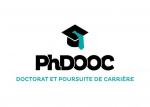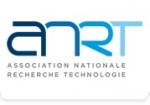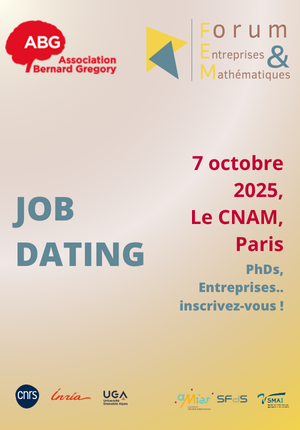Neuromorphic-based digital twin for connected organoids
| ABG-133068 | Thesis topic | |
| 2025-07-30 | Public funding alone (i.e. government, region, European, international organization research grant) |
- Engineering sciences
- Biology
- Electronics
Topic description
- Context and objectives
Characterization and modeling of biological neural networks is an expanding field opening to major advances in our understanding of the mechanisms governing the functioning of the brain and the different pathologies that can affect it. Neuroelectrophysiology requires an accurate understanding of basic mechanisms involved in the functioning and properties of neurons. The complexity of interfacing specific cells in vivo, due to the surrounding native environment, dramatically limits the analysis and interpretation of basic mechanisms. Standard in vitro procedures used by electrophysiologists generally require long-term recordings and accurate monitoring of the electrical activity of the cell. Furthermore, to create bioelectrical therapeutic solution for health care, a real-time bi-directional interface is mandatory. Neuromorphic engineering, initially focused on replicating neuron and synapse biophysics in hardware, has evolved to explore new computational principles, materials, and applications. With their unique ability to emulate brain functions, neuromorphic devices emerge as the prime candidates to revolutionize brain disorder treatments.
Our main objective is to design an embedded real-time bi-directional neuro-hybrid platform with adaptive stimulation depending on spiking neural network (SNN) dynamic: creation of neuromorphic-based digital twin of brain organoid.

Fig 1: Main components of the Neuromorphic Twin and its closed-loop interaction with in vitro brain organoids. Neural recording: The brain organoids are cultured on HD-MEA recording platforms (approximately 1000 electrodes). Neuromorphic Twin: The NT consists of three main blocks. From neural measurements coming from the recording platform, all feature extractions are performed on the ‘hardware for signal processing’ and then sent as input to the ‘hardware for biomimetic network’ block. The biomimetic network, configured offline, emulates the organoid network and reproduces the neuronal activity at the single neuron level. Adaptive Stimulation: At the output of the NT, adaptive, personalized stimulation is produced to correct the impaired biological behavior, thereby restoring healthy dynamics of the organoids.
In this context, this project will specifically aim at:
- Objective 1: Design a real-time artificial organoid (PhD, T. Levi and Y. Ikeuchi)
- Objective 2: Create a real-time embedded neuromorphic system (PhD, T. Levi)
- Objective 3: Develop and implement an accurate neuronal model at unicellular level with details of neurological disorder (PhD, P. Branchereau and Y. Ikeuchi)
- Objective 4: Create new digital twin which performs bi-directional real-time bio-hybrid experiments with adaptive stimulation. (PhD, T. Levi, P. Branchereau and Y. Ikeuchi)
- Objective 5: characterize plasticity and learning on organoids depending on SNN-based stimulations (PhD, T. Levi, P. Branchereau and Y. Ikeuchi)
- Supervision team
This project gathers 3 supervisors, all with extensive expertise and international recognition in their respective fields.
Pr Y. Ikeuchi brings expertise in bioengineering of stem cell-derived brain organoids and analyses of neuronal activity patterns [1, 2, 3].
Pr P. Branchereau at INCIA, University of Bordeaux brings expertise in patch clamp and extracellular recordings, neuron characterization and neurological disorder understanding [4].
Pr T. Levi at IMS, University of Bordeaux brings expertise in neuromorphic system, SNN and closed-loop bio-hybrid experiments [5, 6, 7].
Dr Y. Ikeuchi is one of the pioneers of tissue engineering on stem cell-derived brain organoids to model local and macroscopic circuits within and between brain regions, respectively. T. Levi has collaboration with Pr Y. Ikeuchi since 2017 and published together several papers [1,2,3,5,6]. Pr Y. Ikeuchi is interested in characterizing and modeling his connected organoids’ activity dynamics. Pr P. Branchereau will characterize at single neuron level this brain-organoid system thanks to patch-clamp technique.
The SNN developed by the PhD student will simulate this model to explore the space parameters. The second application of the SNN is to provide, in a closed-loop system, adaptive spatial and temporal stimulations to the brain organoids to modify its dynamics and evolution. These 3 fields (brain organoid, neuron level modelling and real-time artificial neural network) combines perfectly to create a high impact novel bio-hybrid system for neuroscience community.
- Expected outcome:
This unique bio-hybrid platform will allow neuroscientists to go further in their research for analyzing and characterizing neurological disorders and in designing future medical devices like neuroprosthesis. With this neuromorphic-based digital twin, different bioelectrical therapeutic techniques can be tested. This project can lead to major and innovative breakthroughs in sectors such as smart medical devices, and brain-computer interfaces (BCIs).
- PhD Profile:
SNN part will be designed by the PhD and T. Levi’s team. Brain organoid culture are created by Y. Ikeuchi’s team. The PhD student will develop the SNN-based neuromorphic twin of the brain organoids and characterize the stimulation. The background of the candidate should include either computer science, digital hardware, electronic engineering or bio-electronics. The candidate should have a strong interest in interdisciplinary research, and is willing to fully immerse him/herself in the different disciplines, to gain a real/effective multidisciplinary expertise and to become autonomous in the different fields of the project. Good experimental skills are also required. Intensive training in necessary fields will be offered.
The PhD will be half time at the University of Tokyo, Japan and half time at University of Bordeaux, France. The starting date is November 1st or 15th 2025.
Collaboration with U Genova and Pr M. Chiappalone on biological signal processing.
- References:
[1] Kirihara, T., Luo, Z., Chow, S. Y. A., Misawa, R., Kawada, J., Shibata, S., ... & Ikeuchi, Y. (2019). A human induced pluripotent stem cell-derived tissue model of a cerebral tract connecting two cortical regions. Iscience, 14, 301-311.
[2] Kawada, J., Kaneda, S., Kirihara, T., Maroof, A., Levi, T., Eggan, K., ... & Ikeuchi, Y. (2017). Generation of a motor nerve organoid with human stem cell-derived neurons. Stem cell reports, 9(5), 1441-1449.
[3] Osaki, T., Duenki, T., Chow, S. Y. A., Ikegami, Y., Beaubois, R., Levi, T., ... & Ikeuchi, Y. (2024). Complex activity and short-term plasticity of human cerebral organoids reciprocally connected with axons. Nature communications, 15(1), 2945.
[4] Branchereau, P., Martin, E., Allain, A. E., Cazenave, W., Supiot, L., Hodeib, F., ... & Cattaert, D. (2019). Relaxation of synaptic inhibitory events as a compensatory mechanism in fetal SOD spinal motor networks. Elife, 8, e51402.
[5] Beaubois, R., Cheslet, J., Duenki, T., De Venuto, G., Carè, M., Khoyratee, F., ... & Levi, T. (2024). BiœmuS: A new tool for neurological disorders studies through real-time emulation and hybridization using biomimetic Spiking Neural Network. Nature Communications, 15(1), 5142.
[6] Beaubois, R., Cheslet, J., Ikeuchi, Y., Branchereau, P., & Levi, T. (2024). Real-time multicompartment Hodgkin-Huxley neuron emulation on SoC FPGA. Frontiers in Neuroscience, 18, 1457774.
[7] Chiappalone, M., Cota, V. R., Carè, M., Di Florio, M., Beaubois, R., Buccelli, S., ... & Levi, T. (2022). Neuromorphic-based neuroprostheses for brain rewiring: state-of-the-art and perspectives in neuroengineering. Brain sciences, 12(11), 1578.
Starting date
Funding category
Funding further details
Presentation of host institution and host laboratory
TIPS for Innovative Technology For Health (Technologies Innovantes Pour la Santé) explores the properties and applications of the living-electronic interface, in order to better understand certain mechanisms of biophysical interaction or to propose new therapeutic devices. It is based on the establishment of a bidirectional communication between biological tissues and electronic circuits, in vitro or in vivo, in the direction of the acquisition of bio-signals or that of electrical stimulation.
PhD title
Country where you obtained your PhD
Institution awarding doctoral degree
Candidate's profile
SNN part will be designed by the PhD and T. Levi’s team. Brain organoid culture are created by Y. Ikeuchi’s team. The PhD student will develop the SNN-based neuromorphic twin of the brain organoids and characterize the stimulation. The background of the candidate should include either computer science, digital hardware, electronic engineering or bio-electronics. The candidate should have a strong interest in interdisciplinary research, and is willing to fully immerse him/herself in the different disciplines, to gain a real/effective multidisciplinary expertise and to become autonomous in the different fields of the project. Good experimental skills are also required. Intensive training in necessary fields will be offered.
The PhD will be half time at the University of Tokyo, Japan and half time at University of Bordeaux, France. The starting date is November 1st or 15th 2025.
Collaboration with U Genova and Pr M. Chiappalone on biological signal processing.
Vous avez déjà un compte ?
Nouvel utilisateur ?
Get ABG’s monthly newsletters including news, job offers, grants & fellowships and a selection of relevant events…
Discover our members
 Tecknowmetrix
Tecknowmetrix  PhDOOC
PhDOOC  Nokia Bell Labs France
Nokia Bell Labs France  Ifremer
Ifremer  ONERA - The French Aerospace Lab
ONERA - The French Aerospace Lab  ADEME
ADEME  SUEZ
SUEZ  Laboratoire National de Métrologie et d'Essais - LNE
Laboratoire National de Métrologie et d'Essais - LNE  CASDEN
CASDEN  TotalEnergies
TotalEnergies  MabDesign
MabDesign  Institut Sup'biotech de Paris
Institut Sup'biotech de Paris  ASNR - Autorité de sûreté nucléaire et de radioprotection - Siège
ASNR - Autorité de sûreté nucléaire et de radioprotection - Siège  Généthon
Généthon  MabDesign
MabDesign  Groupe AFNOR - Association française de normalisation
Groupe AFNOR - Association française de normalisation  Aérocentre, Pôle d'excellence régional
Aérocentre, Pôle d'excellence régional  CESI
CESI  ANRT
ANRT

